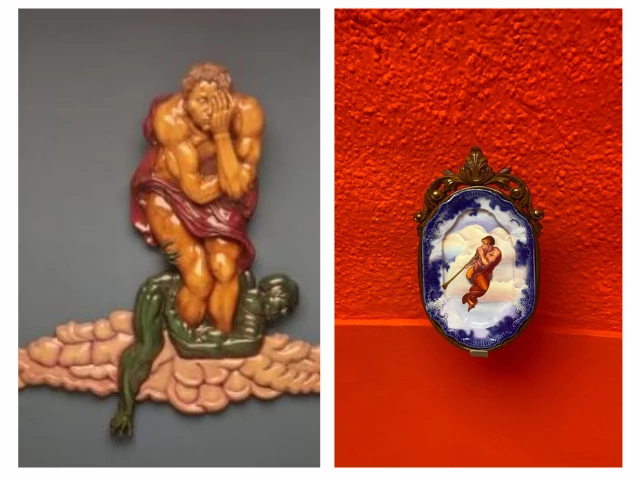Retribution- Adeela Suleman at The Barracks Museum, Lahore
Adeela Suleman’s art delivers a visceral critique of power and violence in 'Retribution'

Adeela Suleman, a contemporary Pakistani sculptor and artist with a long-standing career as an art-practitioner, is renowned for the transformation of mundane objects, the use of metallic repousse-work, embroidery, and the repurposing of antique ceramics, with the singularly purposed and literal construction of a profound socio-political commentary.
Her works epitomise the deployment of irony against Colonialism - external, past, internal and present - and it’s correlates: visually rife with delicate organic motifs, such as birds and flowers, and inhabited with symbols of violence - weapons to be precise - her works reflect on the fragility of life and the pervasive presence of violence. The actual theatre of socio-political repression that Suleman wishes us to pay attention to thereof - and no mistake can be made in this interpretation - is wholly and without respite, that of the human body and psyche under authoritarianism.
Suleman’s most recent exhibition, "Retribution," maintains themes of violence and justice, aligning her, in the first instance, with Greek mythology and Nemesis, the goddess of retribution and vengeance, who embodied the moral force that restores balance by punishing hubris and injustice. In the sculptural figures, there is a definite baroque over-spilling of theorems both egoistic and egotistic by way of which we experience Pakistani space and temporality. However, before attempting a fuller description of the works, and presented with what can only be spoken of as a complex oeuvre that can be spoken of as Suleman’s territorial inquest, and in order to truly appreciate and understand the corpus of her sculptural works and paintings, we must build up, and even more so in her case, a critical framework that extends from the Structuralist Deleuze-Derrida nexus to the psychoanalytic axis of Freud and Kristeva. Furthermore, since her audience’s reception is unavoidably centered on the artisanal, epic and spectacular nature of her works, a comparative discourse needs to be elicited, between Suleman and Anish Kapoor on the one hand, and Jeff Koons, on the other.
To speak of the gravitational space of art and sociopolitical commentary within which ‘Retribution’ operates would, of course, send us back and forth, helter-skelter between pillar and post, in search of precedent and design - an endevour well-practiced and inhibited to some degree by actual attrition, and it’s seemingly zero-sum effect. Suffice it to say that Suleman’s practice thus far is a documented journey of the artist’s voice and it’s impactful reception and resonance within the Pakistani artworld.
Suleman’s invocation of Nemesis, the goddess of retribution and vengeance, is more than an aesthetic or narrative gesture; it situates her work within a universal and timeless framework of justice. Nemesis, as a symbol of moral equilibrium, reflects the exhibition’s emphasis on the consequences of arbitrary authoritarianism. In Suleman’s Retribution, this mythological alignment may serve as both a critique of contemporary societal issues and a metaphorical reflection on the cyclical nature of cause and effect within Pakistani socio-political landscapes. The Baroque is experienced directly by the viewer via the Rubenesque rendition of bloated bodies, as also with the presentation of blaring trumpets. To be sure, the phrase “baroque over-spilling of theorems both egoistic and egotistic” as mentioned above proposes that Suleman’s sculptural figures are richly layered, embodying an elaborate interplay of ideas. The term "baroque", as is known, implies a stylistic intensity marked by dramatic contrasts, intricate details, and emotional exuberance. In the Pakistani context, this aesthetic may also mirror the complexities of space and temporality—how the nation’s identity is shaped by historical violence, colonial legacies, and contemporary struggles for justice. This “over-spilling” is emblematic of the overwhelming and multifaceted challenges that define our socio-political and cultural landscape. With regards to form and meaning, Jean-Paul Sartre viewed Giacometti’s sculptures as revealing the precariousness of human existence. Giacometti stripped his figures to their bare essence, reflecting existential isolation. Suleman, by contrast, uses ornate forms and multiplicity to challenge essentialism, emphasizing the interconnectedness of personal and political histories, uses the Baroque’s visual dynamism to demonstrate how existence is shaped by external forces—power structures, cultural traditions, and collective memory.
Suleman’s body of work, in being called a "territorial inquest," points to an investigative approach that maps both physical and symbolic terrains. Her oeuvre distinctly interrogates boundaries—be they geographic, cultural, or ideological—through her sculptures and paintings. This territorial inquiry could reflect an exploration of contested spaces within Pakistan, including themes of class and power, and how these intersect with broader global phenomena of injustice and retribution. Here, Deleuze’s ideas of multiplicity and difference can help unpack the layered and non-linear narratives within her sculptures, while Derrida’s deconstruction helps illuminate the binaries—justice/injustice, self/other, power/victim—embedded in her artistic discourse. This theoretical scaffolding is especially pertinent for Suleman’s art, as her works seem to operate at the intersection of personal and collective histories, resisting simplistic interpretations and demanding nuanced readings.
To engage with Suleman’s sculptural figures in greater detail, one might anticipate forms that embody a tension between violence and beauty, chaos and order in a dialectic of materiality, in ways that both challenge and reflect their themes. For instance, the choice of medium, the scale, and the intricate detailing might all contribute to the sculptures’ and paintings’ ability to evoke the visceral and the intellectual simultaneously.
Suleman and Kapoor for their part, and Koons on his, occupy distinct yet overlapping spaces within this discourse, particularly in how they engage with themes of humanity and consumerism. While Suleman and Kapoor probe deeply into existential and societal issues, often addressing collective trauma and spirituality, Koons embraces and critiques consumer culture through a hyper-commercialized aesthetic. Suleman’s series After All It’s Always Somebody Else Who Dies transforms intricately patterned steel into haunting depictions of death and violence, subtly critiquing the normalization of brutality in society. Suleman’s art serves as a memorialization of lives lost to conflict, embodying a poignant personal humanity that critiques systemic violence while preserving individual narratives within collective memory.
Kapoor’s works, on the other hand, often explore themes of spirituality, identity, and the human condition. His large-scale installations and sculptures—such as Cloud Gate and Descension—utilize reflective surfaces, voids, and dynamic forms to create experiences that challenge perceptions of space and self. Kapoor’s use of materials such as polished steel or Vantablack emphasizes the infinite and the unknowable, inviting viewers into a contemplative engagement with their inner lives. His works frequently evoke a sense of wonder and introspection, highlighting humanity’s relationship with the immaterial and the eternal.
Both Suleman and Kapoor, therefore, address humanity from a perspective of depth and introspection. Suleman focuses on the tangible consequences of human conflict, while Kapoor explores the intangible and universal aspects of existence.
In stark contrast, Koons’ oeuvre is deeply embedded in the aesthetics and language of consumerism. His art does not critique consumer culture by rejecting it but rather amplifies its elements to absurd and ironic heights. Works like Balloon Dog and Michael Jackson and Bubbles are characterized by a glossy, mass-produced aesthetic, often resembling luxury commodities. By embracing kitsch and blurring the lines between high and low art, Koons reflects on the commodification of art itself and its role within capitalist systems. So, Koons’ work operates as a mirror to a society enamored with surface, spectacle, and consumption, which, it must be said, has not only been the case with segments of Pakistani society, but is now an exacerbated and evident phenomenon. However, while Koons often describes his art as celebratory, critics argue that it lacks the criticality necessary to transcend its aesthetic appeal.
The reason this essay relates and compares these three artists here is the dilemma of authorship and authenticity. Leaving aside Kapoor for the moment, both Koons and Suleman rely heavily on teams of skilled artisans to produce their works. This raises questions about authorship and the authenticity of the artist's hand in the final product, a factor Suleman would be quite aware of by now. Inevitably, for viewers, this can create a sense of detachment from the work, as the visible craftsmanship may appear disconnected from the conceptual vision. No doubt, while Suleman’s works often emphasize the artisanal and traditional craft, Koons deliberately blurs the line between industrial production and fine art. Again, this dichotomy can lead to debates about the “value” of human touch versus mechanized precision, because large-scale works can be visually overwhelming, leading to a focus on their monumental size rather than their conceptual or emotional depth. For Koons, this often translates into the perception of spectacle over substance.
Suleman attempts to evoke reflection on violence or socio-political issues, as noted. Even though the grandeur can sometimes distract from the intimacy of these themes, Suleman is adept at contextualising, as is evinced by the macabre use of illumination and form in Dance In Your Blood. It is not clear whether the words cut out of the metal structures are declarative or propositional: we are neither certain that we are being threatened with the consequences of dissent, nor are we sure if we are being advised to accept the status quo, to mind our own business, to limit your concerns to desiring grand interiors for our homes and to stay busy with ostentatious weddings.
Though monumental works can alienate viewers who feel they lack the cultural or intellectual tools to interpret the pieces, especially when the works are laden with complex symbolism or socio-political critique, Suleman herself mentions the keen interest taken by many attendees at the opening reception of ‘Retribution’. Thus, in dialogue (not for the first time, of course), with her audience and while explaining the technicalities involved in production, she becomes increasingly invested in the perception and resonance of large-scale, artisanally-produced art shaped by the tension between the her conceptual vision and the methods of production, as well, indeed, as the socio-political and economic contexts in which the works are received. For artists like Suleman, the challenge lies in navigating these problems to ensure their works engage viewers meaningfully without being reduced to mere spectacle or commodity.
In her book titled Head Spaces, Elaine P. Miller discusses Julia Kristeva’s thoughts on the relationships between literature, temporality and identity, and writes:
Proust’s version of experience is unique, according to Kristeva, in that the
first flash of Erlebnis occurs always in pairs. The famous petite madeleine, for
example, which inaugurates the entire sequence of reminiscences, exists in
the context of both present and past. The narration follows the continuous
sequencing of the plot, “while remaining caught in the pincers of the immediate
metaphor that removes it from temporal duration and adorns it with the
exhilaration of ‘pure time.’ ” This double movement, which recurs throughout
the novel and which Kristeva calls a “primal metaphorical condensation,”
is experienced simultaneously by both the narrator and the reader.
Kristeva calls this experience one of “rapportive language,” in which understanding
depends on a preexisting affinity of some sort between the communicator
and her audience. The primary representative of such a language
is religious discourse, which to be understood requires faith. However, Kristeva
argues that since religion and even morality have lost their hold on us because
of their excessive restrictiveness or their inability to be heard, the novel has
become the one place in modernity where rapportive language can still make
a claim on us. This affinity can be understood as an imaginative identification
with the narrator that occurs purely through language, without the mediation
of a community or an expert; that is, it is an imaginary experience
that is nonetheless mediated through the symbolic.
Thus, in Suleman, we find an artist whose works can be incorporated without difficulty into the axis of language, narration and the symbolic. ‘Retribution’, the exhibition, becomes meaningful in a fuller sense because it is the creation of an experience that creates rapport with its viewers.
A brief conversation with Adeela Suleman at the Vasl Collective in Karachi showed this writer an artist who now has a greater degree of confidence and clarity about her creative journey. It appears that, since the ‘Retribution” exhibition was initiated by an offer to show at The Barracks Museum in Lahore, this body of work was developed specifically with the location in mind. Suleman admitted to a degree of trepidation: it had been some time since she last exhibited in Lahore; more fearsomely, she was, by her own reckoning, entering the lion’s den in the Punjab. As such, then, her reflections on Retribution suggest a deliberate and thoughtful engagement with location and context. What matters, though, is that she spoke with the assuredness of someone who has an established place in the art world (much like Kapoor who insists on understanding one’s existential responsibilities toward the world around us), yet her demeanor hinted at an eagerness to push her boundaries further. Suleman is not content to rest on her laurels; she envisions her practice expanding into more ambitious and impactful projects, and it would not be out of place to say that she is driven by this profound commitment to exploring complex themes and engaging with broader audiences. She is already a force to be reckoned with, yet her presence, humane and quietly persuasive, suggests an artist in mid-stride, deeply reflective yet forward-looking, ready to embrace the next phase of her evolving career.
- Paul-Mehdi Rizvi is an interdisciplinary artist and art critic, with an interest in developing critical frameworks of art from within contemporary philosophy and psychoanalysis. He can be found at @paulmehdirizvi on Instagram.


















COMMENTS
Comments are moderated and generally will be posted if they are on-topic and not abusive.
For more information, please see our Comments FAQ